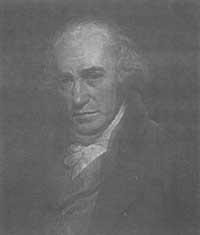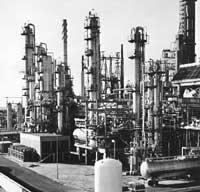Mirandaola: from history to celebration
1993/05/01 Aizpurua Sarasola, Joxerra Iturria: Elhuyar aldizkaria
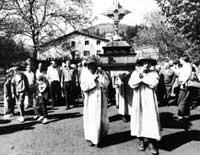
Legazpi has always been linked to iron. Its proximity to forests and mines has long since begun to grow iron. The ferrería has also undergone numerous changes and its reflection is the ironworks that preceded the ferrería. In the attached image you can see the structure of a typical haizeola.
As can be seen in the figure, haizeola was a system with only two holes, and as for its operation can be cited the following general characteristics:
First you had to find iron somewhere. It was not difficult to find iron in the earth's crust. However, iron is not found in the pure state, but in the form of rust. Once the mineral was located, it had to be deoxidized, finding a substance. Wood has mainly carbon and, as is known, carbon reacts very well with oxygen producing carbon dioxide. Therefore, by the upper hole of the wind coal and iron ore were introduced into successive layers.
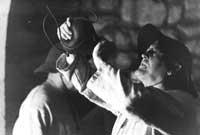
After lighting the fire, the coal burned by heating the iron ore. As iron warmed up, the bond between iron and oxygen was increasingly weak and from a moment on carbon was able to steal oxygen from iron. As a result of combustion two products were obtained, on the one hand slags and waste and on the other rust free iron. The slags, normally in a liquid state, came out of the “naughty” iron mill or were left in the bottom in front of the top hole. Iron was not in a liquid state, but in a viscous state. The obtained iron contained other non-metallic elements, also in viscous state.
Finally, the iron obtained was hammered. Machaqueo had three main objectives: to eliminate the slag, compacting the iron mass and shaping the iron mass.
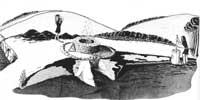
The forms of operation shown here, depending on the place where some changes occurred and the quality of the iron that was intended to be obtained.
All the work to be done in the wind was manual: obtaining and transporting the mineral; obtaining and transporting the coal; reinforcing and maintaining the fire by bellows after the ignition of the fire; hammering the... Throughout history the human being has always sought methods that streamline labor and improve its benefits. XIV. It can be said that in the eighteenth century there was a technological revolution in wind, when the power of water began to be used.
For this reason, the ironworks that were formerly on the mountain approached the river. With the help of water, many ironworks were built. From the nineteenth century and most. They lasted until the 19th century.
In order to explain the characteristics and functioning of the waterfalls, we have taken as a model the Mirandaola ironworks, which is the living witness that we have today.
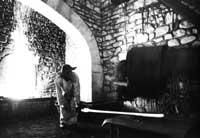
There is no precise data on the creation of the Mirandaola ironworks. We know it was working in 1400 and 1804. Mirandaola, therefore, is a forge that has worked for at least four centuries.
In 1952, by order of Patricio Etxeberria and Teresa Agirre, Mirandaola was rebuilt and since then the patron saint festivities of Santakrutz are celebrated on Sunday 3 May, and only that day Mirandaola is launched.
The general structure of the ironworks consists of five elements.
First a reservoir was needed. The objective of building upstream was double, ensuring the amount of water and having water with high potential energy. This element is not essential as long as the river has enough water and slope.
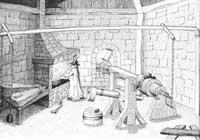
The second is the channel that leads the water from the reservoir or upstream to the ferry. The length of the channels depended on the slope of the river. The higher the slope, the shorter the channel was needed, and the lower the slope, the longer the channel. In the case of the river Urola that crosses Legazpi, the slope of the river is low, so the channels were long. The runway water was poured onto one or more hydraulic wheels by turning. The movement of these wheels is carried through the axes to the gabias and bellows and through the dental crown that has the axis, converts the circular motion, the vertical movement that the gabias and bellows need.
The third is the bellows. In the oven or stove of Oleta a high temperature of deoxydation of the iron ore is required. To do this, enough wind was needed in the stove to burn the charcoal as soon as possible. Normally they were two bellows with opposite movement. As one cast the wind into the fire, the other inflated air.
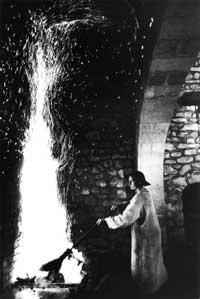
The room is the oven or stove. Charcoal and iron ore were introduced there. The wind from the bellows accelerated combustion and burned coal. At the end of the process was the disposable dross and the agon that would later be transformed.
Finally, there is the gabitegi. Through the gabia the agon is hit obtaining the desired profile. Thanks to these blows of gabi it is also possible to remove the pieces of slag that contains the iron.
The features shown here can be completed in great detail. To regulate the speed of the gabia and bellows, for example, it moved by hand, regulating the amount of water coming from the channel on hydraulic wheels. However, on May 9 you can see what we have told in these lines in Legazpi. In addition, and for the day to pass, there will be pilgrimage.
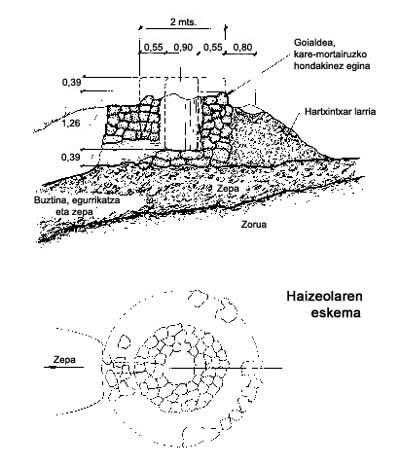

Gai honi buruzko eduki gehiago
Elhuyarrek garatutako teknologia



